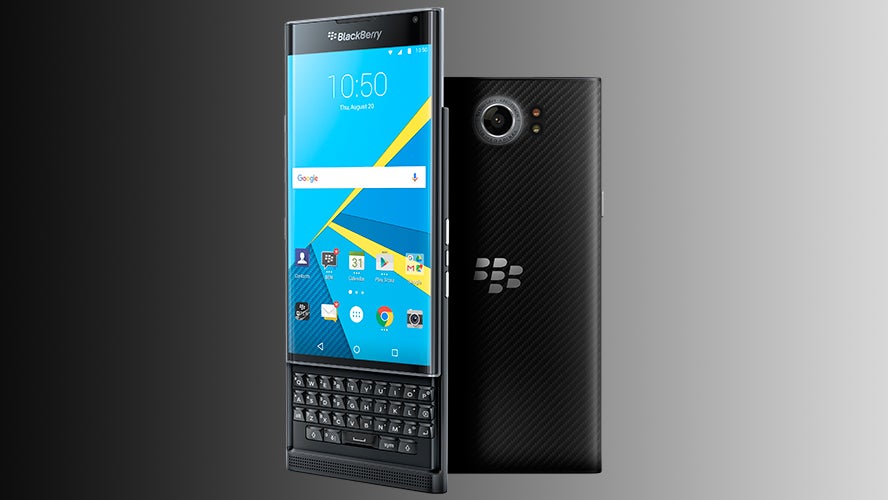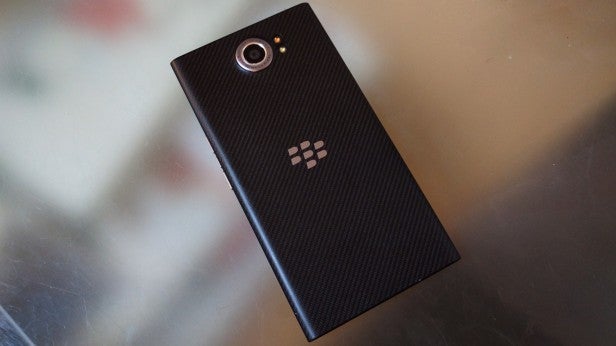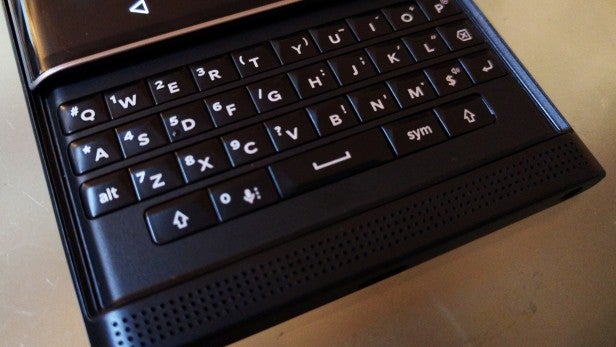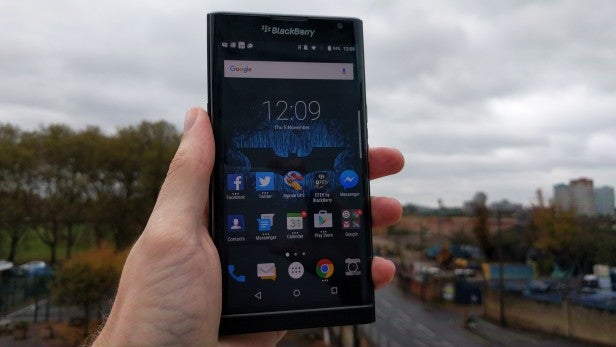BlackBerry Priv Review
BlackBerry Priv
The best BlackBerry smartphone in half a decade

Sections
- Page 1 BlackBerry Priv Review
- Page 2 Software and Performance Review
- Page 3 Camera, Battery and Sound Review
Verdict
Pros
- Unique design
- Rich, sharp and colourful screen
- Robust productivity and privacy features
- Good for keyboard lovers
Cons
- Below-average performance
- Expensive
- No fingerprint scanner
Key Specifications
- Review Price: £560.00
- Android operating system with BlackBerry services
- 5.4-inch, Quad HD AMOLED display
- Qualcomm 808 CPU
- Physical keyboard
What is the BlackBerry Priv?
At MWC, Blackberry will officially unveil the new Mercury. A keyboard toting Android phone that harks back to the brand’s glory days. Will it be a success? Blackberry fans will certainly hope so.
The BlackBerry Priv is a Hail Mary pass by the former tech powerhouse, hoping to revive its fortunes by adopting the Android operating system, resurrecting the slidable physical keyboard, and pushing a wealth of BlackBerry security and productivity services.
It follows the release of several BlackBerry OS 10 smartphones that were great for enterprise, but not so hot for Joe Bloggs, like the squarely business-minded Passport.
This complete rethink of strategy not only makes the Priv the best BlackBerry smartphone in over half a decade, but also one of 2015’s most interesting Android handsets.
Related: 13 best smartphones in 2015
BlackBerry Priv – Design & Keyboard
BlackBerry’s never shied away from experimenting with its designs. It’s done everything from pure touchscreen devices like the Z10, to old-school keyboard phones like the Classic, to outright bizarre handsets like the Passport.
As a result it’s no surprise the Priv’s design is a little different to most handsets, chiefly because it’s a slider phone, with a physical keyboard hidden beneath its main display that can be accessed by sliding the screen up. They were all the rage before Apple’s first iPhone hit the scene in 2007, remember?
The keyboard seen on the Priv isn’t a traditional BlackBerry QWERTY keyboard. It’s an updated version of the capacitive keyboard that debuted on the Passport, which means you can, in theory, use it as a touchpad as well.
The keyboard will be a boon for older buyers and BlackBerry fans, and does undeniably make it easier to edit spreadsheets and text documents. However, to people who’ve grown up on purely touchscreens and those unconcerned with using their phone for work, the addition will feel a little bizarre or unnecessary. This is largely because the Priv’s keyboard is a little too small for my liking.
It’s keys are reactive and well built, but they’re a too close together. Unless you have outright dainty hands you’ll regularly find yourself mashing the wrong key. Within days I found myself using the on screen keyboard by default out of sheer frustration.
This is a little sad as the trackpad functionality works very well, and makes it easy to move the onscreen cursor to the exact point of text you want to edit or highlight without having to awkwardly prod the Priv’s screen.
I’d forgive all of this were it not for the extra weight and thickness the keyboard adds to the Priv. When I picked up the Priv from BlackBerry, a spokesperson on hand made a big song and dance about how competing smartphone companies’ designs are too focused on “making things thin” and that in reality for most consumers “bigger is better”.
After a few seconds suppressing an immature giggle, I realised he wasn’t joking. There’s no getting around the fact that the Priv is giant. Measuring in at 9.4mm thick and weighing 192g, this phone will feel giant unless you’re used to phablets like the Galaxy S6 Edge Plus or iPhone 6S Plus.
Despite its hefty weight, I did find plenty to like about the Priv’s design. With the keyboard hidden the Priv feels a little like a BlackBerry-Samsung hybrid.
The Samsung design comparison begins the moment you see the Priv’s screen, which wraps around the first couple of millimeters of the phone’s long sides – like smaller versions of Samsung’s custom “Edge” displays.
However, flip it over and the design becomes pure BlackBerry. The phone has a “woven” carbon fibre back emblazoned with BlackBerry’s logo.
The combination may sound odd, but I found it gives the Priv a unique and luxurious feel. The carbon fibre’s lightly textured finish proved noticeably more scratch and dirt resistant than competing glass-backed handsets like the Galaxy S6 or Xperia Z5, and also made it easy for me to get a solid grip on the Priv, despite its chunky dimensions.
 e
e
When I did lose my grip and accidentally dropped the Priv onto a carpeted floor, the handset survived chip and scratch free. The sliding keyboard hinge also feels solid and is smooth to use.
However, the back has a lot of flex and noticeably bends when met with even moderate force. This left me concerned about its ability to survive more serious drops or bumps with hard surfaces.
I was pleased to see BlackBerry’s loaded the Priv with a microSD card slot, meaning those that wish to can upgrade the phone’s built-in 32GB of storage. The only potential shortcomings with the Priv’s design are its lack of a fingerprint scanner or USB Type-C port.
USB Type-C is rapidly becoming the new standard in mobile and tablet designs. It promises to offer significantly faster charging and data transfer speeds than the older Micro USB standard.
Fingerprint scanners are en vogue in smartphones at the moment, designed to make it easier for users to secure their handsets. They’ve appeared on numerous other top-end Android smartphones, such as the Galaxy S6, Xperia Z5, OnePlus 2, Nexus 5X and Nexus 6P.
Given how useful I’ve found the scanners on those phones, I’m a little perplexed as to why security-minded BlackBerry hasn’t cooked one into the Priv.
The lack of a fingerprint scanner is partially made up for via the addition of a picture password option. The picture password options make it so you have to drag a chosen number on a randomised grid displayed over a picture to a preset point. The grid changes each time you try to unlock the phone, so people can’t guess it by looking at smudge patterns on the glass.
BlackBerry Priv – Display
Thankfully, the Priv doesn’t come with a square screen, as the Passport did. BlackBerry has instead loaded it with a rectangular 5.4-inch, 2560 x 1440 WQH curved screen.
People may accuse BlackBerry of ripping off Samsung on the curved part, but for the majority of the time the curves are little more than a clever aesthetic element, and the main display’s performance is great.
Featuring a 540ppi density, the screen is as sharp as most competing top-end Android handsets, such as the LG G4 and Samsung Galaxy S6. The high resolution means images and text are constantly sharp and you’ll never once struggle to read web pages, documents or ebooks on the phone.
Thanks to the use of AMOLED screen technology, increasingly being used by numerous Android phone makers, the Priv also has vibrant colours and deep blacks.
Related: 10 Best Android Phones in 2015
It creates colours by electrically charging each individual pixel when generating colours, letting them create deeper, richer blacks simply by turning off the relevant pixels. The deeper blacks in theory help colours to pop out more.
The tech works a treat on the Priv. Blacks are uniformly deep and don’t have the grey tinge seen on competing IPS displays, like the iPhone 6S’s. Colours also look wonderfully rich without being overcooked.
Brightness levels don’t match some handsets, like the Samsung Galaxy S6 or Moto X Style, but are still more than good enough for everyday use – though like 99% of the phones I review, the screen does become difficult to read when hit with direct sunlight.
The only downside to the display is that whites aren’t quite as clean as I’d like. Comparing the Priv to the Nexus 5X, whites have a slightly greyish tone, though they’re far from the worst I’ve seen.
How we test phones
We test every mobile phone we review thoroughly. We use industry standard tests to compare features properly and we use the phone as our main device over the review period. We’ll always tell you what we find and we never, ever, accept money to review a product.


